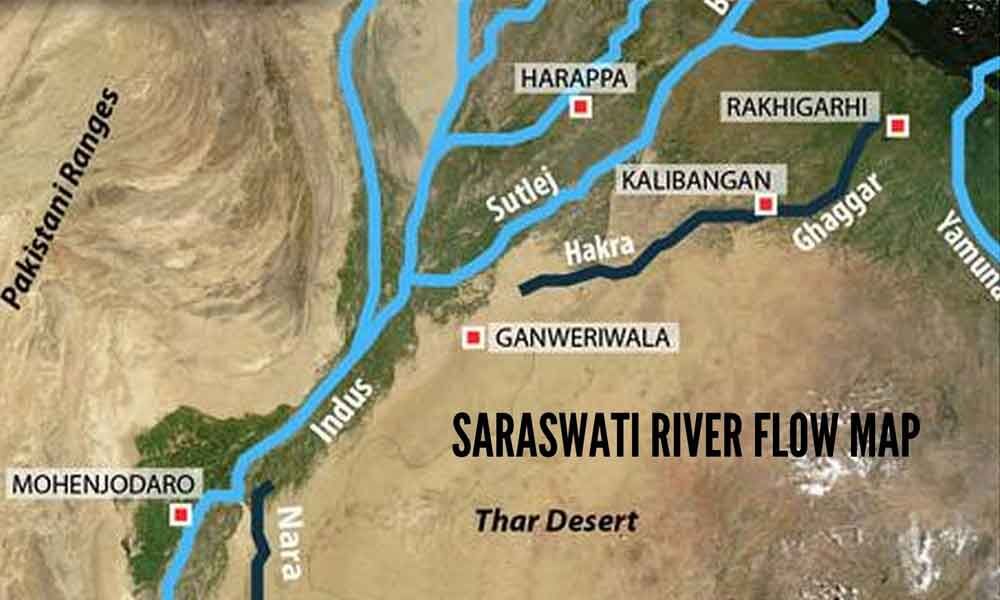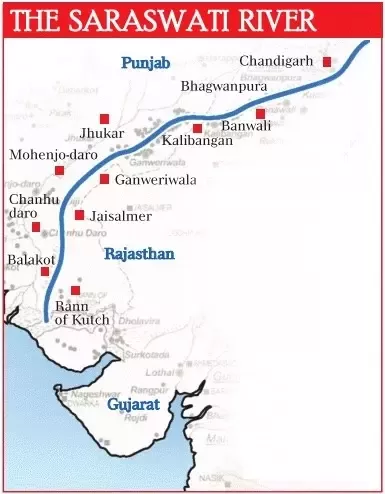
The Saraswati River, as enigmatic as it is revered, has intrigued historians, geologists, and spiritual seekers for centuries. Hailed as a lost river, it has not only inspired a mythological status, but also ignited a sprawling, decades-long series of disputes and studies concerning its very existence. The Saraswati has a distinct presence in the mythology and history of India being considered the lifeline of the ancient Indus Valley Civilisation. In this article, we embark to uncover the missing epic of the Saraswati river, its historical relevance and the science behind the myth.
Historical Significance
Table of Contents
ToggleThe Saraswati River is referred to numerous occasions in old Indian messages, including the Rigveda, one of the most prompt saw religious compositions known to humankind. Rigveda describes the yowestogel Saraswati as a glorious river born of the mountains, flowing from the mountains to the ocean, supporting a mammoth civilization around its banks. Known as the goddess of knowledge, wisdom and purity, the avatar of River Saraswati has been portrayed as a begotten power of the Lord Brahma.
Based on the descriptions in the Rigveda, the river appears to have been one of the most integral elements in the culture of the Vedic civilisation. According to the archaeological evidence, it also has been proved that most ancient civilization Indus Valley Civilization might have been ample by Saraswati. It runs through or near the sites of several ancient indus valley civilisation, such as kAALiibaaNGaaN, rakhiigarhI, DhOLavira (or DaaNaabaaDNaa) etc. These show a well developed urban planning, architecture and social organization, which gives evidence that the river was sustaining a prosperous, sophisticated culture.
Nonetheless, the change took a toll, as a result of which, Saraswati dried up over the course of time, and with the drying of Saraswati between 2000–1900 BCE most of these urban centres disappeared.

Mythological Narratives
One of these Rivers, involved in various Hindu myths is the Saraswati River. The narration of the Puranas, the narrative ancient Indian literature of the universe, states that the Saraswati River was a river originating on the planet as a celestial river. The river Saraswati is regarded as mother in Hindu religion and is the wife of the Creator God in Hindu Religion, Lord Brahma which few places have even affixed the title hence Saraswati River is likened to Goddess Saraswati.
Saraswati, the goddess of knowledge, music, art, wisdom and learning is depicted as sitting on a split marigold river, representing knowledge, and symbolizes the water she pours over the planet through her throat, that nurtures life out of knowledge/wisdom. Mythology also describes how the Saraswati vanished. Legend says the river disappeared, either under a curse or by the hand of the gods, and flowed underground to join the Ganges and the Yamuna at Prayagraj (Allahabad) at a place called Triveni Sangam.
The confluence is said to be one of the holiest sites in Hinduism as it is believed here that sacrifices/bali happen for the salvation of the souls and towards the end after cremation is done family members come to collect ashes for doing ashes immersion wither at Haridwar or other prayedapradesh. The drying up of the Saraswati is more often taken as an oblique way of saying that we lost knowledge and purity over time, that knowledge is lost and therefore it must be preserved, that knowledge is purity and therefore it must be protected.
Scientific Exploration
Many scientific expeditions have been carried out in past to find this mysterious river of Saraswati. Geologists, hydrologists & archaeologists have studied and tried to determine the long-lost path of the river factors responsible for the disappearance of the river. Landsat imagery, remote sensing, and ground surveys have helped to give us some idea of the ancient course of the river and its influence on the landscape. An important breakthrough in this research was the deployment of satellite imagery in the latter half of the 20th century. The scientists found a dry riverbed of the Ghaggar-Hakra River, which they believe may be the ancient Saraswati.
The research shows that it flows through that region of India covering parts of now modern-day India and Pakistan, working in which it would have shared a very different environmental and ecological context than the Sutlej. The Ghaggar-Hakra displays a wide, channelled river bed, and is one of the most extensive of the paleochannels. Additional geological investigations have since found signs of heavy tectonic activity in the area, and the alterations caused to the landscape by the tectonics probably accounts for the fact that the river no longer exists.
These riverbeds are time capsules—a hint that something has moved, shifting the course of the river as tectonic plates moved under their feet. Further, the climate changes around 2000 BCE that reduced monsoon rainfall may have also reduced the water flow, and accelerated the periodic drying up of the river.
Hydro-environmental Parameters
The hydrological studies too have some important linkages of the Saraswati with the glacial melt in the Himalayas! The river is mentioned in ancient texts as having its origins in the Himalayas, revealing links to perennial sources of water. The constant shifts in climate and geological disruptions may have broken this water course, lessening its flow that helped lead to its eventual demise.
Also, perhaps human activity played a hand in why the river declined, too. The result was that the excessive quantities of water used for agriculture, urban construction, etc. could have overtaxed the river, added to the drying out. The building of dams, interference with water channels, and cutting of trees are all well recognized factors leading to the degeneration of river systems, and they could well have been responsible in ancient times too for the dying of the Sarasvati that is recorded in texts such as the Rig Veda.
Cultural and Religious Importance
The disappearance of Saraswati River did not reduce its cultural and religious significance. In fact, the legacy of the film not only felt proud but Indian culture also influenced it further. In the Hindu tradition, the connection made between the goddess Saraswati and the river reverberates even today through its association with the goddess and in dedication to her worship and rituals.
The goddess Saraswati is assured sites of worship throughout India and is the focus of the festival Vasant Panchami, which marks both the first day of spring and the day on which parents traditionally set their children learning to write their first words: education, and the music and dance oft associated with learning, are all areas of tradition in which Saraswati plays a central role In modern times this ancient Saraswati river has been the focus of efforts to remember her.
Initiatives like Saraswati Nadi Shodh Abhiyan (Saraswati River Research Campaign) are an attempt to create a public awareness among the masses about the historical and cultural significance of the river. Research projects are also being carried out along with programs which aim to educate the public and organize cultural events that focused on the importance of the river in the Indian heritage.

Modern Technological Schemes
It is only in the recent past that technology has allowed us to do so. Geophysical mapping using ground-penetrating radar (GPR) and other methods have been used to image structures that might be remnants of subterranean river channels. These studies found subsurface channels of ancient rivers beneath thick sediment layers implying that the Saraswati might have indeed flown through this region in the past.
In addition, the isotopic analysis of old water sources associated with groundwater and thereby hints about the past of the river are predicted. Scientists investigate the isotopic composition of water from modern wells and other sources, to establish the origins and flow paths of water within the region, which adds more evidence of historical presence of such perennial river as Saraswati.
Challenges and Controversies
The Saraswati River project has as many loose threads as bundles — its journey is fraught with multiple hurdles and controversies. Exactly where the river flowed and for how long are still matters of speculation among scientists. Sonnemen’s studie suggested alternate routes and timelines to be pursued, indicative of the rivers’ long, complex or difficult past and the inability of contemporary scientific equipment to answer some of the questions. There are political predispositions and cultural debates that are always associated with the Saraswati subject.
In India, the river is an emblem of natuional pride and heritage consequently, restoration of the river is usually tied to larger cultural and political stories Different publications and an evolving temporal context has inspired a negated identification of the river and beliefs that have then steered research and discourse upon the river’s history.

Conclusion
The Saraswati River mystery is an intriguing mix of history, mythology, and science. An ancient river dating that is mentioned in revered texts, it has a profound place in Indian culture and history. Though exhaustive scientific efforts have helped in unveiling 22 Society secrets, the complete story about Saraswati still stays unresolved.Yet the river’s memory survives; the shared legacy of all Australians; a revelation of the inseparable connection of natural and cultural heritage. Like so many places across the globe, the tale of the Saraswati River is one of lost wisdom…and scientific wonder, a powerful reminder of the lengths to which humanity will go to learn its past — and to keep it. If you like reading this article then please consider reading our article about Lapet.








